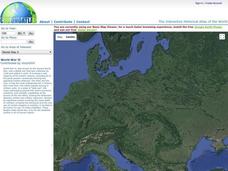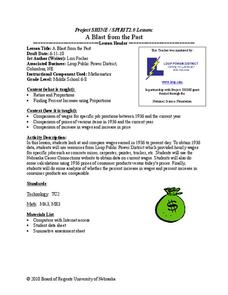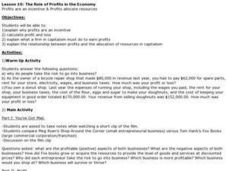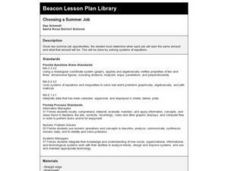Federal Reserve Bank
Would Increasing the Minimum Wage Reduce Poverty?
Here is a fantastic and relevant question to discuss with your class members. Using detailed reading material and a related instructional activity, your learners will learn about labor markets, equilibrium wages, price floors, and...
ProCon
Minimum Wage
The first ever minimum wage in America was set at 25 cents per hour in 1938 and has been steadily, if slowly, increasing ever since. Using the provided website, pupils decide if the United States should further increase the federal...
PBS
The Lowdown — Living Wages in CA: Ratio and Rate in the Real World
How much money is enough money? Future wage earners explore the minimum hourly wage and then use it to calculate monthly and yearly earnings. They use an interactive to consider living costs and determine whether earning a minimum wage...
Anti-Defamation League
The Gender Wage Gap
"Equal pay for equal work!" may sound logical but it is not the reality. High schoolers begin a study of the gender wage gap with an activity that asks them to position themselves along a line that indicates whether they strongly agree...
Federal Reserve Bank
“W” Is for Wages, W-4 and W-2
Don't let your young adults get lost in the alphabet soup of their paychecks and federal income taxes. Using sample pay stubs and reproductions of government forms, your class members will identify the purpose of such forms as a W-4 and...
Curated OER
Beat, Earn and Win Exercise
In this vocabulary recognition activity, students read examples of using the terms beat, earn and win, apply them to fill in the blanks completing sentences, and create additional sentences. Students write 18 answers.
Smithsonian Institution
Strength in Solidarity: Coalition of Immokalee Workers and the Campaign for Fair Food
Not all food is created equal. The lesson plan dives into the world of migrant farm workers to show their struggles to earn livable wages and better working conditions. Academics learn why the Coalition of Immokalee Workers was created...
Curated OER
Hire the Best Unit
Students complete a activities to improve their career awareness. In this career awareness lesson, students complete a 41 page packet of activities to learn how education can increase earning power, learn about employer attitudes and...
Curated OER
High Earners Can Still Struggle
High schoolers explore the concept of financial trouble. In this financial trouble lesson, students read an article about people who earn large salaries, but still have financial trouble. High schoolers discuss ways to avoid and get out...
Curated OER
Inequalities in the Workforce
Fourth graders examine careers that differ in the amount of wages paid to women and men. They interview their parents and discover they are contributing to society. They discover their role within the community as well.
Curated OER
Creating Line Graphs
Students draw line graphs. In this math lesson plan, students interpret minimum wage data and graph the data in a line graph. Students predict the next minimum wage and figure the earnings for a 40 hour work week for someone earning the...
Curated OER
Earned Income Credit
Students distinguish between tax deduction and tax credit, explain how the earned income credit affects the tax liability, apply requirements to claim the earned income credit, and describe factors that determine the amount of the earned...
Illustrative Mathematics
The Price of Bread
As part of an initiative to strengthen our young adults' financial understanding, this problem explores the cost of bread and minimum wage since the 1930s. Learners are asked to find the percent increase from each year and compare it...
Curated OER
Take It To the Bank
Examine how the economics of a school store relate to real world economics. Elementary students explore various websites, complete a Venn diagram, create a schedule of wages for the students, read the book "A Chair For My Mother" and...
Illustrative Mathematics
Who Has the Best Job?
Making money is important to teenagers. It is up to your apprentices to determine how much two wage earners make with their after school jobs. Participants work with a table, an equation, and a graph and compare the two workers to see...
Curated OER
Your First Job
High schoolers determine that they are responsible for paying income taxes through withholdings on earned income. They examine the Form W-4.
Curated OER
Wages, Earning Power, Profit, and Responsibility: International Lessons
Students participate in an interactive activity to determine where their clothers were made. They examine the lives of children from Latin America who harvest crops in the fields or manufacture apparel in factories.
American Institute of Physics
African Americans and Life in a Secret City
Imagine the lure of being offered a job at a secret site, working on a secret project, and earning higher wages! Such was the approach used to recruit African Americans to Hanford, Washington, one of several sites used to develop...
Curated OER
A Blast From The Past
Students investigate ratio and proportion as they solve problems. For this algebra lesson, students calculate the percent increase on salaries and convert between decimals and percents to calculate. They rate job positions from 1936 to...
Curated OER
Creating Line Graphs
Students relate data to coordinate graphs and plot points on this graph. They use minimum wage data to construct the graph. Students decide appropriate time intervals for the graphs. They share graphs with their classmates.
Curated OER
The Role of Profits in the Economy
Young scholars discuss the role of profits in an economy. As a class, they explain why profits are an incentive and practice calculating profit and loss. They discover what a firm in capitalism must do to earn profits and explain the...
Curated OER
Choosing a Summer Job
What did you do over your summer vacation. Young wage earners must compare summer job options, and determine when each job earn the same amount and what that amount be. This be done by creating, graphing, and solving systems of...
Curated OER
Savings and Earnings
Fifth graders complete several activities to learn about earning, budgeting, and saving money. In this saving money lesson, 5th graders read a book about saving money and complete a 'Savings and Earnings' worksheet. Students work in...
Curated OER
Where Do We Get the Money We Spend?
Students discuss the sources of income for people in their community. They examine why different jobs are paid different wages. They also classify productive resources in the economy.

























